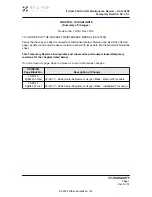
THRUSH AICRAFT, INC - MODEL S2R-R1340
AIRCRAFT MAINTENANCE MANUAL
10 - 2
Effective: 01/01/08
GENERAL DESCRIPTION
The aircraft 24-volt DC electrical system
is designed to provide the utmost in
reliability. One 24-volt storage battery
provides electric current for engine
starting and a reserve source of electrical
power in the event of alternator failure. A
D.C. power receptacle located on the
engine mount, left hand side of the
fuselage (see Figure 10-1 B), provides a
means for connecting external power to
the aircraft electrical system. To
conserve battery life, external power
should always be used for starting
engines when temperature is below 40
°
F
or when performing maintenance
requiring electrical power. An alternator
powered by the engine is the primary
source of electrical power to the main
bus. The electrical system is protected
by a voltage regulator and circuit
breakers. If the alternator’s output
voltage is below bus voltage, the battery
supplies the busloads. The D.C.
ammeter, installed on the right
instrument panel, indicates the discharge
or charge on the battery after the engine
is started. All electrically-operated
motors, lighting systems and other
electrical component circuits are
protected by push button thermal circuit
breakers. Switches and instruments
required for operation of the aircraft
electrical system are installed in the left
instrument panel and engine control
switch panel (Figure 10-1 E and F).
POWER DISTRIBUTION
The 24-volt D.C. electrical system can
receive electrical power from three
different sources: battery, external power
and the alternator. With the engine
operating and the alternator on the line,
electric power from the alternator is
provided through a circuit breaker to the
main bus.
BATTERY AND EXTERNAL
POWER
One 24-volt storage battery provides
power to the circuit breaker through
relay(s). The relays are controlled by a
two-position (BAT OFF-ON) switch
located on the engine control switch
panel (Figure 10-1F). Placing the battery
switch in the ON position closes the relay
to supply power to the right hand panel
power distribution buss from the battery
or external power receptacle. Placing
the battery switch in the OFF position de-
energizes the battery relay and
terminates the supply of power to the
electrical system from either of these
sources.
BATTERY SERVICING
Initial servicing of a dry charge Gill G-244
battery is as follows:
A. Remove seals (if present) from cells.
B. Fill each cell with 1.285 specific
gravity sulfuric acid to bottom of split
ring. Use only glass, rubber or
plastic materials for containing
battery electrolyte fluid during
servicing and wear protective
clothing and rubber gloves when
handling electrolyte to prevent
personal injury. Use a solution of
baking soda and water to neutralize
any acid spilled on clothing, skin or
any damageable surface.
C. Sway the battery from side to side to
release any trapped air. Re-adjust
the electrolyte as necessary.
D. Let battery sit unused for one hour.
E. Check and re-adjust electrolyte level
as necessary by adding more
electrolytes to obtain proper level as
stated in procedure B.
F. Install vent plugs tightly into each
cell.
















































